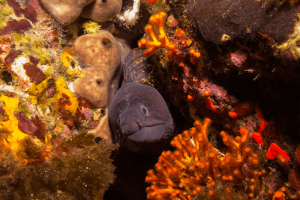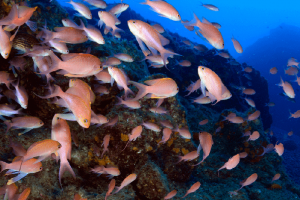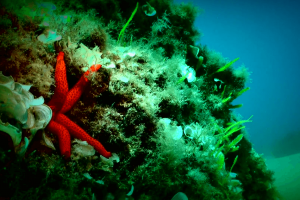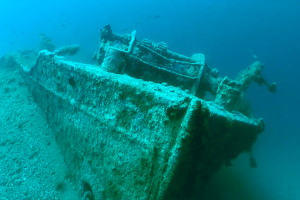Dive Sites
La Montagna

depth: 35/40m
Very famous among the most experienced divers, La Montagna is a huge rock monolith, more than 20 meters high, and is considered by many one of the most beautiful diving sites in the Mediterranean Sea. This thanks to the incredibly biodiversity of this place: red-yellow corals, Anthias, Cerianthus, and red algae can be found there in great numbers, making the hole site very colourful. La Montagna can be reached easily from the diving center and can be visited by every diver has an AWD certification or more.
La Grotticella

depth: 32/40 m
The central part of this diving site is a passing cave with wide both entrance and exit, whose inside walls are covered by white sponges and yellow anemones. The place around is rocky, rich in yellow-red corals and inhabited by stingrays and sea eagles. When the currents are still, it is possible to visit a centuries-old white Ceriantus that lives near the upper entrance of the cave. La Grotticella can be visited by any diver who has a AWD certification.
Il Castello

depth: 15/30m
Il Castello (“The Castle”) is named after the famous Ruffo Castle of Scilla. In fact, this dive consists in a trip around the rocky shore beneath the Ruffo Castle. The place is rich in small caves, some of whom are accessible. Several fishes can be found here all year long, with their population varying according to the season. At night, the place is swarmed with mollusca and crustacea, especially shrimps. This dive is suitable for every kind of diving level.
La Secca delle Ombrine

depth: 25/42 m
Placed close to Grotticella, it can be visited following different pathways, like a 30 meters deep wall, fully covered by red and yellow corals or the upper part, rich in holes populated by benthonic fishes, mollusca and crustacea. The two most striking features of this place are a Leptogorgia colony, a rare Mediterranean anemone, and the presence of a white Ceriantus living on the sand. Great pelagic fishes can be spotted reaching the surface. Clean water and limited depth make this dive easily accessible.
La 'Mpaddata

depth: 30/70m
´Mpaddata is the biggest and most various of massive underwater rock complexes in Scilla. It has two very different sides: on the harbour side a wall rich of astroides, violet sponges and other colourful invertebrates; the other side, facing the open sea, sinks rapidly to high depths and it is completely covered with big two-colour corals. Often big fishes are met, such as basses, sea eagles and barracuda flock. Below 58 meters, there is a beautiful cave accessible only to divers with advanced skills.
La Secca delle Cento Cipolle

depth: 28/42 m
In the local dialect, the “cipolla” term indicates big red rockfishes, the fish which characterises the dive through its massive presence. On the top of the rock there are many tunicates as well as big predator fishes. Slightly deeper a huge coral field can be found. On the deep west side, there is a broad cave populated by big shore rockling. Thanks to its small size the whole perimeter can be explored, spotting the biggest murena of the area. The outer side sink rapidly to the deep sea, making this site suitable also for more advanced dives.
La Pietra Voia

depth: 9/12 m
The Pietra Voia consists in two almost identical 10 meters tall monoliths which face each other. The dive is easy and relaxing, but still rich in encounters and colours. White sand and posidonea can be found all around the diving site. Recommended to practice and refresh diving skills.
La Luna

depth: 10/30m
Rather particular among the diving sites in Scilla, it consists almost entirely on a journey to the great white sand sea bottom in front of Marina Grande. The name is inspired by the almost “moonish” looking of this place. One of the most beautiful encounters which are possible during this dive are the stingrays living here, who can be spotted with a little bit of luck. This dive is relatively easy and accessible to any diver.
Il Bosco degli Spirografi

depth: 15/25 m
Really easy dive, it consists in a journey to the colourful spirograph “forest” that grows in Archi, Reggio Calabria. These wonderful invertebrates create a very interesting ecosystem around them where particular sea life can be found, such as trumpetfish, oloturians and paguri. In this place, it is also possible to spot sea horses living among the spirografi. The site is also very interesting at night.
Il relitto di Cannitello

depth: 27/42m
The Vapore di Cannitello is a shipwreck from the early 20th century, probably sunk after an explosion of the steam engine. Broke into two parts, it lies upside down in front of the beach of Cannitello and can be reached easily without boat. The internal structures of the wreck were almost destroyed in the years, but the inside part of the ship can be visited from different accesses. The entrances are all large and bright, so the wreck is very safe to visit and offers many beautiful points of view for photographers. Inside can be found the typical sea life of dark waters, like huge white sponges and lots of yellow anemones; inside the holes in the wreck live also many seabasses and moray eels. Anthias can be seen all around the place.
Il relitto di Lazzaro

depth: 36/45m
The shipwreck of Lazzaro was a German transport ship, sunk after a sea storm during the last years of WWII. The dive starts from the beach, from whom the wreck can be reached simply by swimming. The maximal depth for this diving is -45 meters and the mechanical structures of the ship are well conserved. This site is beloved among photographs and is accessible to all divers who have at least an AWD cerification.
La Secca dei Francesi

depth: 58/70 m
This rock complex lies near the diving center and was discovered and visited for the first time by the Cousteau crew. It is a very famous diving site, but still little visited due to the important depth and the difficulty to avoid currents. It is a place reigned by the Anthipates, the black Mediterranean coral, which is present here in great numbers. This coral, with his white and smooth body, make this place feel magical. On the south-west side of the complex a huge rock arch can be found, where lots of seabasses and Anthias live.

